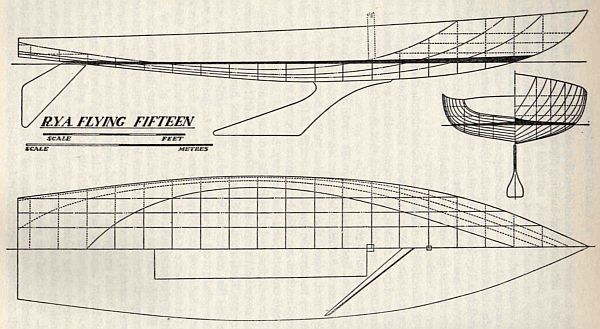The Flying 15 was designed by Uffa Fox in 1947 and the first hulls built at his Cowes based boatyard. Uffa recounts in his 1959 book, "Sailing Boats" that Jimmy Damant, a Commodore of the Island SC and one of the earliest owners of the International 14, had often encouraged him to; "Design a boat like the 14-footer, but at least 18ft long, that will not capsize. Then you would have a sensible, safe boat, that was fun to sail as well, for the rough and tumble of tidal waters like the Solent."
Uffa eventually drew-up a hull twenty foot overall, fifteen foot on the waterline and drawing nine inches without the keel. The steeply raked keel adds 2ft 6inches to the draft, the rake helping to remove any weed. The original construction was for a 1/8" thick diagonal inner skin and 3/16" fore and aft, honduras mahogany outer skin over 3/8" x 1/4" ribs at 2" centres. The deck was 3/16" marine plywood. The original design weight was 285lb for the hull with a 400 lb keel. Driving this was a sail plan and mast height exactly as for the International 14 of that period.
The latest specifications can be found on the Flying Fifteen International website.

Construction methods in the early years were wide ranging, traditional carvel, moulded ply, aluminium, tufnol, and fibreglass being used, before the latest hulls settled on an epoxy foam sandwich with carbon used in high stress areas, which gives a significantly stiffer structure and long competitive life.
A number of well known UK builders constructed 15s in their preferred method . . . including Uffa himself, Medina Yacht Yard, Jack Holt building number 16, Chippendale & Wyatt, Tormentor who built No. 192 Coweslip, presented to HRH Duke of Edinburgh and Princess Elizabeth as a wedding present. Uffa Fox and Prince Philip frequently sailed together at Cowes. And the famous 202, Silver Fox which won championships from 1957 to 73. Even in those early days of the class boats were sailing in Zimbabwe (No. 2) Australia (No. 9) Ireland (No. 10) Jamaica (No. 42) USA (No. 86) Canada (No. 87) and New Zealand (No. 96), even some five boats recorded in Iraq in the 1950s.
For many years the class had traditional wide building tolerances and this led to much experimentation to obtain the best shape for a given sailing location. Eventually Roy Windibank, who sailed at Hayling Island SC, developed a series of moulds which produced fibreglass hulls that dominated the class from the early 80s, winning the Worlds in 1984 and six Nationals with the mark IV. This mould was cloned and used in Ireland, South Africa and Australia. This was followed by the mark IX, which after winning the 1988 Worlds, went to Dave Ovington, where it was later refaired to become the Ovington Smoothie and the basis of a tightening of the construction tolerances in 1993. After ten years of production this was replaced with the Ovington Mk 10, their current production mould.
The Flying Fifteen has been modernised over the years with Uffa Fox agreeing to changes towards the end of his life to improve the design specification and sail plan. By this time, the class had established itself in a number of countries and when John Calvert-Jones came from Australia and won the UK championships, the stimulus was provided for the move to seek international status.
Under the guidance of Tom Ratcliffe, an International Federation of Flying Fifteen Associations was formed by nine countries from four continents. The first world championships were held in Perth, Australia in 1979 and subsequently have alternated between the Northern and Southern hemispheres biennially. The first European Championship took place in Spain in May 2004.